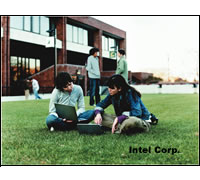
South Dakota, Maine, and Wyoming top the list of states with the highest percentage of schools that have ubiquitous (one-to-one) computing programs for their students–while California (50) ranks last in this category, according to new research compiled from school databases and surveys.
The information is the latest to come out of Project RED: Revolutionizing Education, a yearlong effort from a group of educational technology researchers and market analysts to measure how technology can help schools save money and improve instruction. (See “Project seeks to measure ed tech’s value.”)
Project RED researchers began by creating a database of high-tech schools that all have roughly the same number of computing devices as students. The comparison of where states rank according to the percentage of their schools or students with ubiquitous ed-tech access comes from an analysis of this database. (Numbers in parentheses throughout this report indicate a given state’s rank in terms of ubiquitous access.)
The database reveals a national average of about 5.4 percent of schools with ubiquitous technology programs, reaching about 4 percent of students.
Once Project RED forms an advisory board, researchers will choose several states with exemplary ed-tech initiatives to serve as showcase states.
States with smaller populations, such as Missouri (11), Kansas (4), and Nebraska (6), have done a great job in ensuring students’ access to classroom technology, said Jeanne Hayes, a Project RED manager and CEO of the Hayes Connection, an ed-tech consulting firm.
Often, it’s easier for less populous states to implement statewide education technology initiatives, Hayes said, because they have a smaller percentage of the national student population and the costs of such initiatives are less.
For instance, Maine (2) has 800 schools with fewer than 214,000 total students–0.4 percent of the U.S. student population. Because the student population is so small, Hayes said, Maine is financially able to reach about 23.5 percent of its students with ubiquitous technology.
In contrast, many people consider Connecticut (30) to be an affluent state, but only 4.1 percent of the state’s schools have ubiquitous ed-tech programs, according to Project RED’s research.
States such as Texas (17), Florida (20), and New York (29) have invested heavily in education technology, but the actual percentage of their students served by ubiquitous technology programs is small owing to the states’ sizes.
But for a large state, Texas’s rank in the database is quite impressive, Hayes said. Texas has nearly 5 million students and has managed to provide ubiquitous access to technology in nearly 8 percent of its schools.
To advocates of education technology, the top two states in Project RED’s list–South Dakota and Maine–should come as no surprise, because both states have implemented statewide school laptop programs in recent years.
And although budget-troubled California (51) hopes to invest heavily in technology, it occupies the lowest spot in the rankings, reaching only about 1.2 percent of its students with ubiquitous computing. The state’s size–it holds 12.5 percent of U.S. students–works against it, Hayes said.
California’s ranking suggests many of its schools could have trouble capitalizing on Gov. Schwarzenegger’s interest in promoting free, open-access digital textbooks. The trick, Hayes said, will be to figure out a way to boost students’ access to computing devices while taking advantage of its proximity to Silicon Valley in an affordable way.
But Hayes recognizes this is just one way of ranking states’ ed-tech efforts.
“It isn’t the end-all, be-all of how they’re using technology,” but it’s an interesting snapshot of technology access in U.S. schools, she said.
Many larger, rural states, such as Nebraska (6) and Montana (7), have well-established online learning programs that reach students in remote areas or connect students to courses and programs that might not be available where they live, Hayes said.
And though the chart’s outline is relatively firm, the database might change as more successful one-to-one technology programs in different states come to light.
Hayes said Project RED is still searching for feedback and data from public and private schools that have ubiquitous technology programs. Schools that are using laptops, cell phones, iPods, and other devices are encouraged to visit the Project RED web site and submit their information.
Links:
Project RED state-by-state chart (Excel)
- Friday 5: Universal Design for Learning - April 19, 2024
- Educators love their edtech, but want more training - April 18, 2024
- Friday 5: College and career readiness - April 12, 2024


